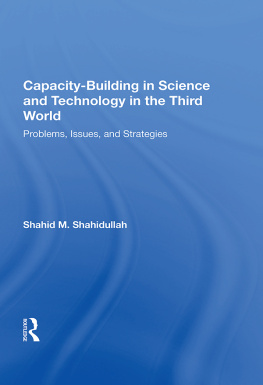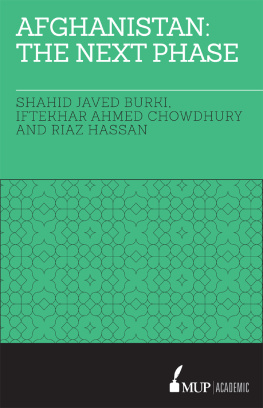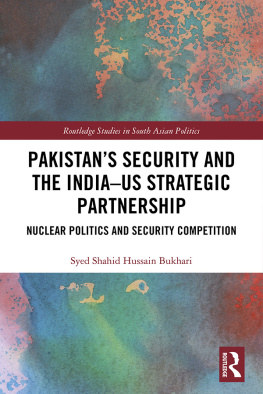Capacity-Building in Science and Technology in the Third World
First published 1991 by Westview Press
Published 2018 by Routledge
52 Vanderbilt Avenue, New York, NY 10017
2 Park Square, Milton Park, Abingdon, Oxon OX14 4RN
Routledge is an imprint of the Taylor & Francis Group, an informa business
Copyright 1991 by Taylor & Francis
All rights reserved. No part of this book may be reprinted or reproduced or utilised in any form or by any electronic, mechanical, or other means, now known or hereafter invented, including photocopying and recording, or in any information storage or retrieval system, without permission in writing from the publishers.
Notice:
Product or corporate names may be trademarks or registered trademarks, and are used only for identification and explanation without intent to infringe.
Library of Congress Cataloging-in-Publication Data
Shahidullah, Shahid Muhammad, 1952-
Capacity-building in science and technology in the third world :
problems, issues, and strategies / Shahid M. Shahidullah.
p. cm.
Includes bibliographical references and index.
ISBN 0-8133-7948-2
1. Research institutesDeveloping countries. 2. Engineering
ResearchDeveloping countries. I. Title.
Q180.6.D44S53 1991
338. 926091724dc20
89-48378
CIP
ISBN 13: 978-0-367-01475-9 (hbk)
To my parents, who loved me throughout these years, and to my beloved wife, Runu, who inspired this work but did not live to see it completed
Contents
Part One
The Conceptual Framework
Part Two
Problems, Issues, and Strategies
Guide
During the past five years while I was working on this book, I had opportunities to discuss the problem of science development with a number of reputed scholars in the field. I would first like to thank S.N. Eisenstadt, Donald T. Campbell, and Burkart Holzner. I would particularly like to express my profound appreciation to the late Joseph Ben-David. Ben-Davis ideas about institutionalization of science, Eisenstads thesis about the centrality of the role of strategic elites in modernization, Campbells notion of science as a unique social system, and Holzners concept of the knowledge system all remain at the core of my discussions of many of the issues of science development in the Third World.
I also had opportunities to share my ideas with many of the Third Worlds practicing scientists, sociologists of science, and science policy advisers. I received particularly thoughtful feedback from Aquiel Ahmed, Shamsuzzoha Talukdar, Dhiren Misra, M. Habibullah, Humayun R. Siddique, Osman Ghani, M. Waheeduzzaman, Dilip Paul, Habibul H. Khondker, Talukdar Maniruzzaman, M.G. Kibria, Bashir Abugeillah, Bruno Podesta, Jose A. Villegas, Majid Rahnema, Arshad Khan, Debasis Chakraborty, Belayet Khan, and Ali Alghafis.
This book would not have been possible without the patronage I received from the University Center for International Studies at the University of Pittsburgh and a grant given by them to support the completion of this work. I am particularly grateful to Burkart Holzner for his guidance at critical moments of progress in this effort. I am also grateful to Glema Burke, Thomas McKechnie, and Lisa Rosenberg for their continued encouragement.
William N. Dunn, Vijai P. Singh, and Jiri Nehnevajsa all read earlier versions of the manuscript. William Dunn provided important conceptual information about problems of knowledge use in policymaking. I owe a great debt of gratitude to all of them.
Carol Parry edited this work with a high degree of sensitivity and competence. Carol has conducted research in the Third World and is well aware of its cultural conditions. Her concept of the Culture of Fear has enhanced my understanding of the particular problems of science inherent in authoritarian regimes. I am grateful for her intellectual contributions as well as her editorial skills.
Thanks also to Ann Tomer and Sherry Brennan for their editorial assistance in the initial stages of writing this manuscript.
Ellen E. Williams of Westview Press provided support and made prudent suggestions from the very beginning of this work. Her involvement in the completion of this work has been highly valuable.
Rochelle Cook, Emily Mathers, and Chris Zarnich typed the manuscript with the utmost care and without complaint. Mitchell Bjerke and Elizabeth Bjerke helped me with the final typesetting of the manuscript. I am thankful to all of them.
Finally, none of the people whose names have been mentioned above are responsible for the mistakes which remain. For the mistakes, only I am to blame. But I also believe, as renowned mathematician Jacob Bronowski once said, All information is imperfect. We have to treat it with humility. That is the human condition; and that is what quantum physics says."
Shahid M. Shahidullah
Part One
The Conceptual Framework
1
Introduction: The Problem of Science and Technology Development in the Third World
The Third World is comprised of more than 100 independent states in Asia, Africa, and Latin America. There is an enormous diversity in their respective histories, people, and cultures; yet, they share many similarities in their progress, problems, and plight. Nearly three quarters of the worlds 5.4 billion people live in the Third World. The total population of China and India alone is more than the combined populations of North America, Western and Eastern Europe, and the USSR. Between now and the year 2025, more than 3 billion people will enter the worlds population. About 90 percent of them will reside in the Third World and share its concerns. For most people, thoughts of the Third World evoke images of poverty, hunger, famine, and inexorable underdevelopment. The Third World is a land of immense richness and immense poverty, of astonishing hope and constant despair. These countries have a vast reservoir of talented men and women who create magnificent art, music, literature, and philosophy; yet, at the same time, more than 700 million men and women suffer daily starvation, and millions of children die every year before they reach the age of 2. Despite these obstacles, Third World countries continue with a promethean struggle for change and development. The panacea commonly believed to help in this struggle is modern science and technology. Panacea or not, modern science and technology are at the core of advancing development in the Third World.
In the past decades, enormous concerns were expressed for science and technology development in the Third World. A number of international conferences and symposia such as the 1963 United Nations Conference on the Application of Science and Technology in Underdeveloped Areas (United Nations, 1963); the 1967 Beirut International Conference on Science and Technology in Developing Countries (Nader & Zahlan, 1969); the 1974 United Nations Regional Plan of Action for the Application of Science and Technology to Development in the Middle East (United Nations, 1974); the 1978 Buenos Aires Plan of Action for Promoting and Implementing Technical Cooperation Among Developing Countries (Seligman, 1988); the 1979 Mexico Symposium on Science and Technology in Development Planning (Urquidi, 1979); the 1979 Malaysian Symposium on Science, Technology and Global Problems (Radhakrishna, 1980); the 1979 Singapore Symposium on Issues of Development: Towards a New Role for Science and Technology (Goldsmith & King, 1979); the 1979 Jamaican Symposium on Mobilizing Technology for World Development (Ramesh & Weiss, 1979); the 1979 United Nations Conference on Science and Technology for Development (United Nations, 1979a); and the 1986 Seminar on Technology Policies for Development and Selected Issues for Action organized by the Islamic Development Bank and United Nations Conference on Trade and Development have firmly recommended that science and technology must be considered as an integral part of development in the Third World. In order to develop, Third World countries must be capable of producing, organizing, and using scientific and technological knowledge according to their respective needs, problems, and potentials.









